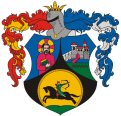

The village is found to the south-east of Pécs, in the vicinity of the town. It has a population of 5300. Its history is rooted in the early Bronze age, as indicated by archeological findings. Remains of the Roman times have also been found here. The transcontinental military road connecting Mitrovica-Pécs-Szombathely-Sopron, led not far from the place. The Avars living here between the 6th-9th centuries also left some relics behind. Several tombs have been found dating back to the time of the Hungarian conquest.
The village got its present form when two smaller settlements: Kiskozár and Misleny were united in 1928. The name of Kozár was fist mentioned in documents in 1332-1335, in the papal tithe registers, in the form Kosar. Misleny was first mentioned in a document dating back to 1266, as Myslen. The place played an important role in the development of Baranya county. Originally there were two areas, each governed by a castle built in their centres. One of them was Baranyavár, the other Koaszt with its centre somewhere beiween Kozármisleny and Nagykozár. Baranya county developed out of these two areas.
Kiskozár was inhabited continuously, even under the Turkish rule. In the l7th and l8th centuries South Slav families settled next to the Hungarian population. Some of them got assimilated, others moved away after some time. Around 1760, German settlers came and by the middle of the last century they were in majority. : Misleny was inhabited under the Turkish rule, and in the 17th-18th centuries its population was partly Hungarian and partly Slav.
After the war of independence led by Rákóczi, only the Hungarians remained. The Roman Catholic church of the village was consecrated in 1971. Inside visitors can admire the statue of St Margaret of Scotland. The new Roman Catholic church, built as a part of the convent, belongs to the St Francis of Assisi Sick Nurses. Its construction began in 1993 and was consecrated on March 31,1997, to St Nicholas of Flü (Klaus Ruder, patron saint of Switzerland). The designs were made 3 by Ottó Vince, yount architect living in Pécs. At present Kozármisleny boast the full range of infrastructure and enjoys a dynamic development.